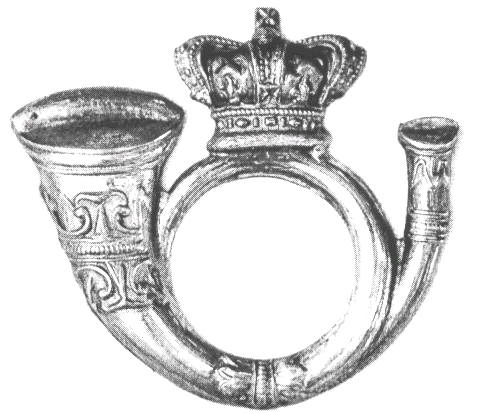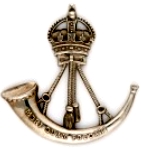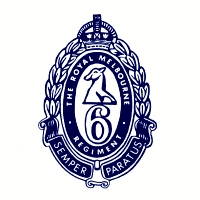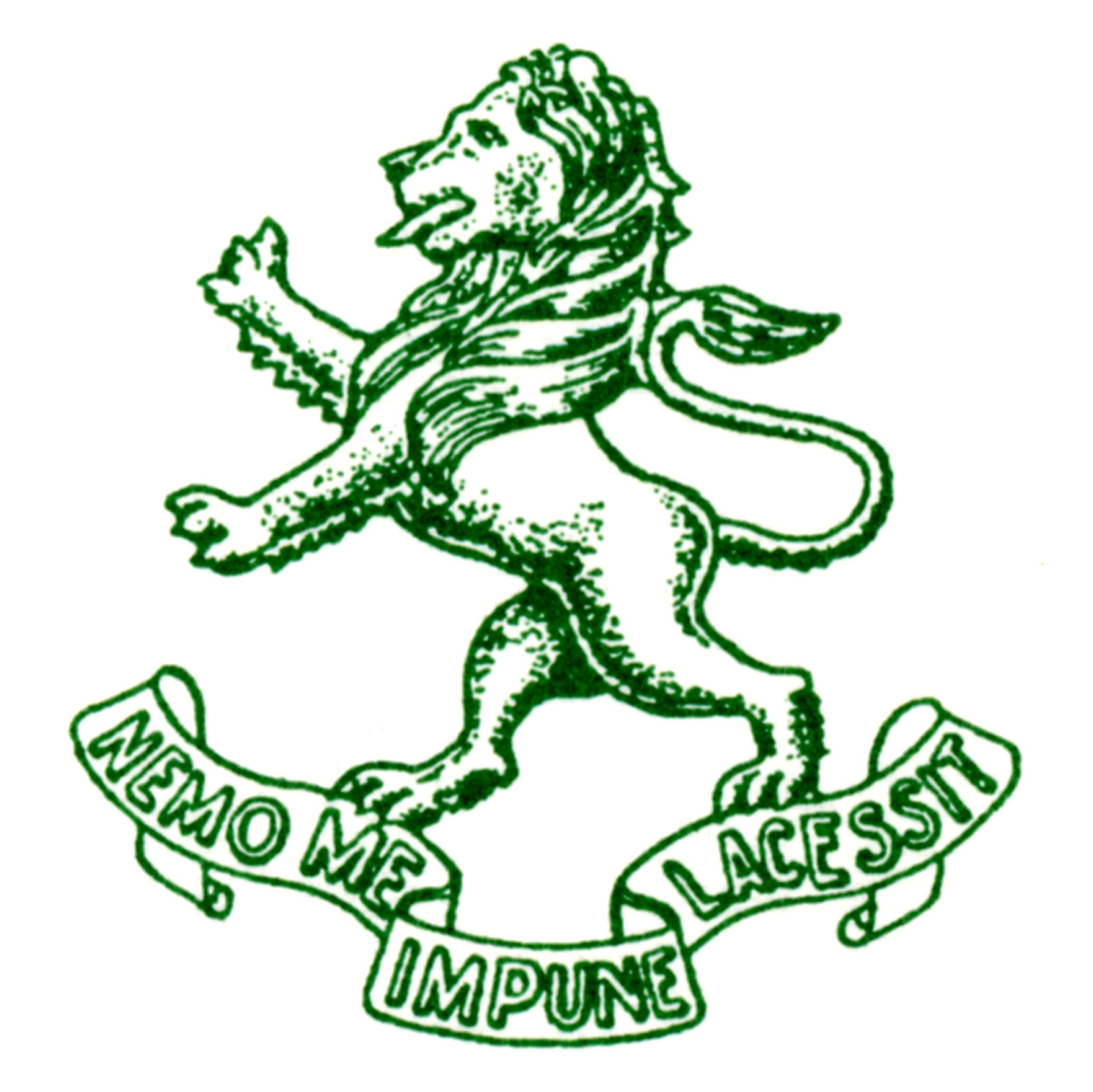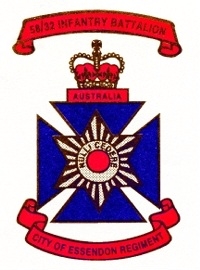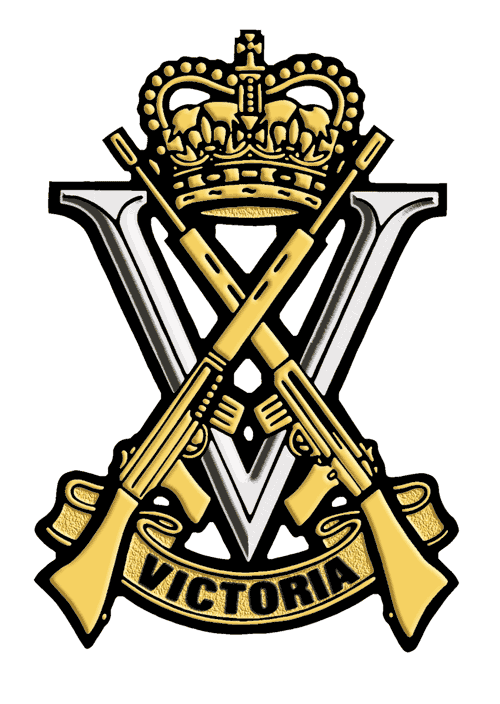  Sesquicentenary
Sesquicentenary
Melbourne Volunteer Rifle
Regiment
5th/6th Battalion,
The
Royal Victoria Regiment
THE ROYAL VICTORIA REGIMENT
(an history of)
BY Captain Ron Austin, RFD, ED
Extract from 1993 book
“NEVER FORGET AUSTRALIA – N’OUBLIONS JAMAIS L’AUSTRALIE”
The Royal Victoria Regiment, under that title which was adopted on 1st July, 1960, is a non-tactical grouping of all infantry battalions raised by the citizens of Victoria from time to time. Units are added to or removed from the Order of Battle in accordance with Australian Government defence policy as deemed necessary to meet changing threats to the Nation's security. As such, the Regiment is the repository of the history and traditions of all battalions from the State from earliest times until the modern day.
The early history of the Colony of Victoria provides a fascinating insight into the development of the Australian Army and how our attitudes on defence were shaped. During the early and middle part of the 19th Century, the defence of the Port Phillip District, and later the Colony of Victoria was the responsibility of the British Army.
Attempts had been made to colonise the area near Corinella in Western Port Bay, in December 1826, under the protection of the 3rd Regiment of Foot. Although this settlement was abandoned in March 1828, a new settlement was established, at what was to become Melbourne, in 1835. With the discovery of gold in 1851, the demands for additional military units to enforce order on the goldfields and to provide gold escorts, led to the arrival of the 40th Regiment of Foot, 2nd Somerset Shire, in October 1852.
Two events occurred in 1854 that were to dramatically affect the fledgling colony. In early 1854, a report by Captain Ross, RE, on the colony's defences had aroused some debate, but little activity. However, when news of the outbreak of the Crimean War between Britain/France and Russia reached Victoria, the ensuing apprehension led to a reappraisal of the colony's defences. Due to the prompting of John Hodgson, the Mayor of Melbourne, steps were taken to form unpaid volunteer units in Melbourne and Geelong.
The Melbourne Volunteer Rifle Regiment, commanded by Colonel W A Anderson, ex 65th Foot, was formed in November 1854. The creation of a local military force coincided with the troubles at Ballarat, where detachments of the 40th Foot, quickly suppressed the miners' revolt at Eureka. Few military units can claim that their official place of parade was a hotel, but, the new Melbourne unit which was the direct antecedent of the 6th Battalion, the Royal Melbourne Regiment, paraded at the Criterion Hotel, until December 1854, when they were permitted to use the Princes Bridge Barracks. The unit had several name changes in a short period of time, and in January 1856, the regiment was changed following a vote of the members, from an infantry unit to the Victoria Volunteer Artillery Regiment. Apparently this change came about because it was thought that an artillery unit was a more appropriate way of defending the colony.
Interest in the volunteers waned over the next couple of years, until sparked by fears of a war between Austria and Sardinia and French colonisation of New Caledonia. About 2,000 people attended a public meeting held in the Exhibition Buildings in July 1859. As a result of that meeting, the Governor, Sir Henry Barkly, authorised the formation of the Victoria Volunteer Rifle Corps.
The new corps of some 1600 volunteers was to be formed, with companies in Melbourne, Richmond, Collingwood, North Melbourne, Prahran/South Yarra, St Kilda, Emerald Hill, Hawthorn/Kew, Pentridge, and Williamstown. The existing Geelong Rifle Regiment was to be augmented by companies at Belfast (Port Fairy), Portland and Warrnambool. By 1860 the volunteer force of infantry, cavalry and artillery units in Victoria had increased to over 3,000 men. The need for a larger local defence force was exacerbated by the departure of the British units to fight in the Maori War in New Zealand. It was the subsequent amalgamation of the Melbourne, North Melbourne, Carlton and Pentridge Companies, some years later that led to the formation of the 1st Metropolitan Battalion. It was in Easter 1861 that the first annual camp was held at Thomas Chirnside's property at Werribee.
In October 1863, the Victorian Government reorganised the volunteer corps into 13 volunteer rifle companies, plus artillery and mounted units. Two months earlier, the Prince of Wales had agreed to the existing Mounted Volunteer Corps to be retitled The Prince of Wales Victorian Volunteer Light Horse. The popularity of the revitalised defence force was evident on New Year's Day 1864, when 15,000 spectators watched a Military Review by 2,500 troops at Emerald Hill. The traditional morning training parades were, by 1865, replaced by evening parades, which like the institution of annual camps, persists to this day.
Just as new units were flourishing in metropolitan Melbourne, a number were also being formed in country Victoria. In the early 1860s, Volunteer Rifle Corps and Ranger units were formed which covered districts such as Ballarat, Bendigo and Castlemaine.
In August 1870, the 2nd Battalion (Royal Irish), which was the last British unit in the colony, had left Victoria, and the growing colony was now totally dependent on its own resources for immediate defence. A Royal Commission on the Volunteer Forces was held in 1875. The Commission recommended a small, well-drilled force under the command of an Imperial Officer. The recommended size of the force was to be 3,400. In 1882, the first permanent unit was formed in Victoria - the Victorian Garrison Artillery Corps.
The appointment of Sir Frederick Sargood, as Victoria's first Minister of Defence in 1883, led to the replacement of the volunteer system, by a part time paid militia force, with the 1st Battalion (West Melbourne) of Victorian Rifles carrying on the tradition of service started in 1854. The Victorian Rangers was reorganised into three country battalions around this time. In 1887, the Victorian Defence Forces leased 476 acres of land at Langwarrin, and the first of many Easter Camps was held at the new location.
The citizens of Victoria loyally backed their new militia with the first general parade held at East Melbourne on 28th June, 1884, at a strength of 14,674 out of a total population of only approximately 250,000.
An early problem to arise was contention as to whether the new militia units were liable to serve outside the Colony. This assumption, continued into the Commonwealth Military Forces after Federation, was to hinder the organisation and deployment of the Australian Army until after the Second World War.
The early 1890s was not a good period for Victoria in economic terms. Government expenditure was cut in a wide range of areas, including defence.
Private soldiers in the militia had their pay reduced by 16% in 1892, and by a further 25% in 1893. This had the effect of reducing the size of the military by about 1800 men. In 1898, the Victorian Scottish Regiment, later to become the 5th Battalion, was formed, adopting the tartan and customs of the Gordon Highlanders. In March 1901, the newly formed Commonwealth of Australia took over the Victorian Defence Forces.
It should be remembered that only a year or so earlier, Victoria had responded to Britain's call to arms, and provided 3,626 men for the Boer War in South Africa, of whom 126 died. The Regiment carries the Battle Honour, South Africa 1899-1902, in recognition of their service.
The Commonwealth's assumption of its responsibility for defence led to a reorganisation which saw the formation in Victoria of the 5th, 6th, 7th and 8th Australian Infantry Regiments, the Victorian Scottish Regiment and the Victorian Rangers. Following the visit of Lord Kitchener, and his subsequent report to the Australian Government on how the new nation should be defended, a scheme of compulsory training was introduced in 1911, and the existing Army units reorganised into the Citizen Force in 1912, comprising, in Victoria, twenty-five infantry battalions numbered from 45-71 (less 61 and 68) Australian Infantry Battalions. For example, the 5th Australian Infantry Regiment was divided and the Melbourne element was retitled the 64th Infantry (City of Melbourne); the Victorian Scottish Regiment was designated the 52nd Infantry; the Ballarat based 7th Australian Infantry Regiment was split into the 70th and 71st Infantry; the Victorian Rangers and 8th Australian Infantry Regiment became the 67th (Bendigo) and 73rd Infantry.
Upon the outbreak of the Great War in August 1914, the Australian Government immediately offered the British Government an infantry division for service overseas. This offer was accepted with alacrity. Recruiting for the Australian Imperial Force or AIF as it was commonly known, opened in mid August, and there was a flood of adventurous and patriotic volunteers eager to serve overseas.
The newly formed AIF battalions of the 1st Australian Division were soon filled with officers, NCOs and men from the Citizen Force battalions as well as volunteers without prior military service. As the Regular Army was only approximately 3,000 all ranks, of the original officers of 1st Division, 493 came from the Militia as opposed to 99 from the Regulars. The original Victorian brigade was the 2nd Australian Infantry Brigade consisting of the 5th, 6th, 7th and 8th Battalions. The 5th and 6th enlisted recruits from Melbourne and the suburbs, while the 7th enlisted from Mildura and western and northern Victoria, the 8th recruited from the Ballarat area. The Brigade Commander was a capable citizen-soldier, Colonel (later Lieutenant General Sir) James McCay, a solicitor from Castlemaine, and the first battalion commanders were:
- 5th Battalion - Lieutenant Colonel D S Wanliss, a lawyer of Ballarat;
-
6th Battalion - Lieutenant Colonel J M Semmens, a public servant of Rushworth;
-
7th Battalion - Lieutenant Colonel H E Elliott, a solicitor of Melbourne;
-
8th Battalion - Lieutenant Colonel W K Bolton, a senator of Ballarat.
The brigade completed its initial training at a camp near Broadmeadows, and on 19th October, the convoy sailed from Port Melbourne, arriving at Alexandria in Egypt, in early December 1914. The troops were railed to Cairo, where camp was established at Mena, at the foot of the pyramids. After several months hard training in the desert, the AIF was ready for battle, but instead of going to France to fight the Germans, the Australians and New Zealanders sailed for Gallipoli, the gateway to the Straits of the Dardanelles.
The combined British and French naval assault on The Narrows in March 1915, ended in ignominious retreat following the loss of several battleships. The naval defeat led to a major military operation being undertaken against the Turkish Army along the Gallipoli coastline. General Sir Ian Hamilton, the Commander of the Mediterranean Expeditionary Force, planned a series of dawn landings along the Gallipoli Peninsula with a view to confusing the enemy as to the direction of the main attack. The Australian & New Zealand Army Corps (ANZAC) was given the task of landing in the Gaba Tepe area, the British 29th Division at Cape Helles, and the French at Kum Kale on the Southern shore of the Dardanelles.
The 3rd Brigade commenced landing at around 4.30am on Sunday, 25th April, followed by the 2nd Brigade at around 6am. Unfortunately, the ANZAC landings were made at Anzac Cove near Ari Burnu, a mile to the north of Gaba Tepe. This mistake meant that the original plans were thrown into disarray, as the commanders and troops attempted to cope with the difficult country they now had to tackle. The ground around Ari Burnu consisted of precipitous hills covered with low thorny vegetation. As the Australians climbed up the uninviting hills, the waiting Turks rained rifle and machine gun fire onto them. Yet despite such odds, some small parties of Australians managed to penetrate deep into the Turkish territory. By dusk the Australians held the first two ridgelines despite repeated counter attacks, and over the next few days consolidated their precarious toehold. The bravery shown by countless young Australians on that sunny April morning set the standard for all future Australian soldiers. The citizen army of the new nation from the Antipodes demonstrated by its deeds that it was capable of playing its role on the world stage.
It was but a fortnight later that the 2nd Brigade and a New Zealand brigade sailed down the Gallipoli coast to assist the Allies in a fresh offensive at Cape Helles. It was not until late on the third day of the battle that the Australians were committed to the battle, which was later known as the Second Battle of Krithia. At 5.30pm on 8th May, the 2nd Brigade advanced across open fields towards the Turkish lines in front of' the village of Krithia, The four Victorian battalions, with the 6th and 7th in the lead, weathered a storm of enemy fire as they advanced the Allied line a further 600 yards. The British war correspondent, Ashmead-Bartlett witnessed the attack and wrote;
³The manner in which the Australians went forward will never he forgotten by those who witnessed it. They advanced steadily, as if on parade, sometimes doubling, sometimes walking. They melted away under the dreadful fusillade.²
In the space of one hour, the 3,000 strong 2nd Brigade had suffered over a thousand casualties. The 6th Battalion lost 433 men killed, the highest loss for the unit for any day of the war. The Colours of the current 5th/6th and 8th/7th Battalions of the Royal Victoria Regiment recall the bravery of these Victorian soldiers. The next major battle for the Australians was the attack on Lone Pine by the 1st Brigade at 5.30pm on 7th August. The attack on the enemy Positions at Lone Pine involved ferocious fighting in the enemy-held underground galleries. Turkish attacks and counter-attacks continued for some days before the situation was resolved in the Australians' favour. A total of seven Victoria Crosses (the highest bravery award in the British Empire) were won, including four on the same day to members of the Victorian 7th Battalion, who joined in the fighting on 8th August - Lieutenants W Symons and F Tubb, Corporals A Burton and W Dunstan. Despite the valour of the Australians, it was obvious that a stalemate had been reached. The Turks could not eject the Allies, who in turn could not reach the Dardanelles. This led to the decision to evacuate the Allies from Gallipoli. Fears of a costly evacuation were fortunately not realised, as the deception and evacuation plan went smoothly, the Australians being evacuated in December 1915 and the British in January 1916.
The Anzacs returned to Egypt where they spent the next few months training in the hot Sinai Desert. News of the battles at Gallipoli had stimulated recruiting back in Australia, and the large numbers Of men now in Egypt, enabled the authorities to create new battalions by halving the existing ones and supplementing the old and the new with reinforcements. The 5th Battalion spawned the 57th, the 6th the 58th, the 7th the 59th, and the 8th Battalion the 60th Battalion. The four new Battalions formed the 15th Brigade. In this way many officers and men from the original 2nd Brigade found themselves involved in the battle of Villers-Bretonneux. Not least was Brigadier General H E Elliott who had been CO of 7th Battalion at Lone Pine. It was Elliott who commanded the 15th Brigade from 1916 to 1918. The divisions set sail for France from late March, and by early April, the troops were facing German units, and learning the differences between trench warfare in Gallipoli and France. The obvious difference was of course the plentiful use of artillery by both sides in France.
The first major battles fought by the Victorian battalions were at Fromelles and Pozieres during July and August 1946. The Battle of the Somme had commenced on 1st July, and the Australians were given the task of capturing the German lines near the small French village of Pozieres. It was here that the Australians encountered ferocious and almost unceasing German artillery bombardments. Corporal Arthur Thomas of the 6th Battalion wrote in his diary:
“Made a move forward into a seething hell and my God, what sights! Our chaps have been cut up - if a man gets through it, it will be a marvel. Last night's inferno is printed in our minds in red ... Hundreds of shells from big 12 inch howitzers are being fired at us. God! It is cruel.”
The enemy shelling at Pozieres set the standard by which all future operations on the Western Front would be measured. It was here that Private T Cooke of the 8th Battalion won a posthumous Victoria Cross. Following Pozieres, the 1st Division, including the 2nd Brigade, travelled up to Belgium, and then back to France in time to participate in the Bullecourt battle. It was during the Bullecourt battle that Lieutenant R Moon of the 58th Battalion won a Victoria Cross. From there they returned to Belgium to participate in the Third Battle of Ypres. The 5th and 6th Battalions advanced through Glencorse Wood 5.40am on 20th September 1917, during which time 2nd Lieutenant F Birks of the 6th Battalion won the Victoria Cross. By mid-morning the 1st Division had reached Polygon Wood.
The fearful cold, wet winters on the Somme and in Flanders added to the strain of being frequently shelled by the German guns, and when news of a huge German offensive reached the Australians who were marching toward the Somme, the men had to turn around and march back to Flanders to halt the German offensive. It was on the Le Motte-Vieux Berquin Road that the CO of the 6th Battalion, Lieutenant Colonel C Daly, DSO was killed by a German shell. A bronze memorial plaque to Colonel Daly and the men of the 6th Battalion killed in France, was donated by the author and erected in the village of Herleville in May 1992.
In April 1918 the Germans made a desperate last bid to win the war before the expected massive American build-up. As part of an effort to split the Allied forces and seize the Channel ports, on 24th April they successfully flung four divisions against a weakened British division holding Villers-Bretonneux, the key to Amiens and the ports beyond. The formation on the British left was the Victorian 15th Brigade, commanded by Brigadier ‘Pompey’ Elliott, who anticipated the German actions. He received approval to launch an immediate counter-attack with his 15th Brigade hooking North of the town and the 13th Brigade to the South. The bold plan against massive odds was a complete success, resulting in ‘perhaps the greatest feat of the War’ and the bayonet charge amongst ‘the wildest in the experience of Australian infantry.’
The German offensive was successfully halted and in August 1918, the Australian Corps under Lieutenant General Sir John Monash, broke the shackles of the costly trench warfare that had restricted both sides since 1915, and commenced to advance east from Amiens. The 2nd Brigade was involved in two very costly infantry battles at Lihons on 10th August, and at Herleville Wood on 23rd. It was during the Lihons battle that Private R Beatham of the 8th Battalion, won the Victoria Cross. In the latter battle Lieutenant W Donovan Joynt of the same battalion won the Victoria Cross. As an example of the ferocity of the fighting, the 6th Battalion had entered the Herleville battle with 16 officers and 417 men, and came out of the battle with 6 officers and 141 men. The Battle Honours won by the Victorian battalions are emblazoned on the Queen's and Regimental Colours now carried by the 5th/6th and 8th/7th Battalions of the Royal Victoria Regiment.
Over the four years of World War I, Victoria sent on active service nineteen infantry battalions. A total of 112,399 Victorians (equal to 38.6% of the male population aged 18 to 44 years) enlisted in the AIF, of whom the majority served in the infantry. Casualties were higher in proportion to any other part of the British forces - 65.98% of those who embarked for overseas service - indicative that Australian infantry having gained a reputation as effective and capable fighting soldiers were often in demand as shock troops.
Victorian infantry won 35 different Battle Honours or, if counted as separate awards to the individual battalions, 335 separate awards of a Battle Honour. Sixteen Victorian infantrymen won the Victoria Cross. Whilst the AIF battalions were overseas, their sister militia battalions were maintained back in Australia. When the war was over, twenty-one infantry battalions were re-raised but the units were renumbered so as to reflect the existing territorial links and acknowledge the deeds of the AIF battalions. For example, the Victorian Scottish Regiment was renumbered as the 5th Battalion, the 64th (City of Melbourne) as the 6th Battalion, the 66th (Mt Alexander) as the 7th Battalion, and the 70th and 71st (Ballarat) as the 8th Battalion. Compulsory training was abandoned by the Government in 1929 and this had the effect of immediately reducing the size of the existing regiments. However, by the mid 1930s, the regiments had re-established themselves as thriving units. The 6th Battalion in 1935 had bestowed on it the title The Royal Melbourne Regiment and was until after the end of World War II, the only infantry regiment in Australia bearing the Royal title.
The outbreak of the Second World War in 1939, saw the formation of a volunteer Second AIF, which maintained the numerical designations used by the Great War battalions. Unfortunately, due to the territorial policy referred to earlier, the existing militia battalions were not called up for overseas service, although they again fostered the formation of the AIF units. One infantry division was raised initially, designated 6th Division, and Victoria was responsible to raise its second brigade, called 17th Brigade, to be made up of 2nd/5th, 2nd/6th, 2nd/7th and 2nd/8th Battalions (the prefix ‘2’ distinguishing them from the militia battalions which continued under the same numerical designations). The original Commander of 17th Brigade was Brigadier (later Lieutenant General Sir) Stanley Savige, a company director from Melbourne and the first Commanding Officers were:
- 2nd/5th Battalion - Lieutenant Colonel T P Cooke, a bank officer of Melbourne,
-
2nd/6th Battalion - Lieutenant Colonel A H L Godfrey, an auctioneer of Geelong,
-
2nd/7th Battalion - Lieutenant Colonel T G Walker, a bank officer of Hampton;
-
2nd/8th Battalion - Lieutenant Colonel J W Mitchell, a company director of Melbourne.
The 2nd AIF was increased to four infantry divisions (6th, 7th, 8th and 9th) and Victorian battalions served in each. At the same time the militia was increased from five to eight divisions (1st, 2nd, 3rd, 4th, 5th, 10th, 11th and 12th). Of these, the 3rd and 11th served outside Australia on active service. Following a change in Government policy due to the direct Japanese threat to Australia, militia units were for the first time allowed to serve outside the geographical limits of the country. A number of Victorian militia battalions did so with distinction - e.g. 7th, 8th, 14th/32nd, 22nd, 23rd, 24th, 29th/46th, 37th, 39th (credited with stopping the Japanese capture of Port Moresby and inflicting the first ground defeat on the Japanese Army), 52nd, 57th/60th and 58th/59th.
Victorian infantry served in all Theatres of War in which Australian troops participated, winning 88 different Battle Honours or, if counted as separate awards to the individual battalions, 214 separate awards of a Battle Honour. Two Victorian infantrymen won the Victoria Cross.
The part-time militia units lapsed after the war ended in 1945. However, the onset of the Cold War, prompted the Australian Government in 1948, to reform the part-time volunteer militia under the title - Citizen Military Forces (CMF). In Melbourne, the 5th Battalion (Victorian Scottish Regiment), 6th Battalion (Royal Melbourne Regiment) and 58th/32nd Battalion (City of Essendon Regiment) were raised, and in country Victoria the 8th/7th Battalion (North West Victoria Regiment), 38th Battalion (Bendigo Regiment) and 59th Battalion (Hume Regiment). In 1960, a massive reorganisation was instituted throughout the Australian Army. The so-called “Pentropic” structure saw all the existing Victorian CMF units subsumed by the Royal Victoria Regiment (RVR). The metropolitan battalions became 1st Bn RVR, and the country units 2nd Bn RVR. The traditions that the older regiments had built up for over 100 years were hurriedly and, without thought or sensitivity, cast aside. But, within five years, the Pentropic experiment was abandoned. This meant the reinstatement of the 3 units: the 1st Bn RVR (formed from 58th/32nd Bn personnel) 5th Bn RVR and 6th Bn RVR - together again in 4th Brigade. Later, 22nd Bn (Bushman's Rifles) was added. Due to the decline in recruitment, following the Vietnam war, in 1975 the 1st Bn RVR was disbanded and the 5th and 6th joined to be the 5th/6th Bn RVR.
This battalion in 1993, is now the sole metropolitan infantry battalion in Melbourne, with the 8th/7th Bn RVR operating from its Headquarters in Ballarat to cover the bulk of country Victoria. However, in the case of 5th/6th Bn RVR, the traditions of its predecessors are again recognised and it is hoped that at some future date, 5th/6th Bn RVR will be in a position to divide and again form the 5th and 6th Battalions in their own right, as with the case of 8th/7th Bn RVR.
The two serving battalions now form part of the Australian Army's Field Force and have been allotted real and important tasks to protect vital assets in the North of the country in the event of a defence emergency. Members train for these roles and are liable for call-out to full-time service on Government order and, unlike their predecessors, for service anywhere in the World.
It is often incorrectly assumed that Australia and its Army lacks the traditions found in some of the long established regiments in Britain and Europe. However, it is evident from this very brief overview of the Royal Victoria Regiment, from its humble beginnings in the latter half of the 19th Century, to the current day, that it is an Australian Regiment with a long and proud tradition and a fascinating history. The long list of Battle Honours won by Victorian infantry battalions, bears witness to the many different parts of the World in which the Victorian infantryman has served with distinction.
|
